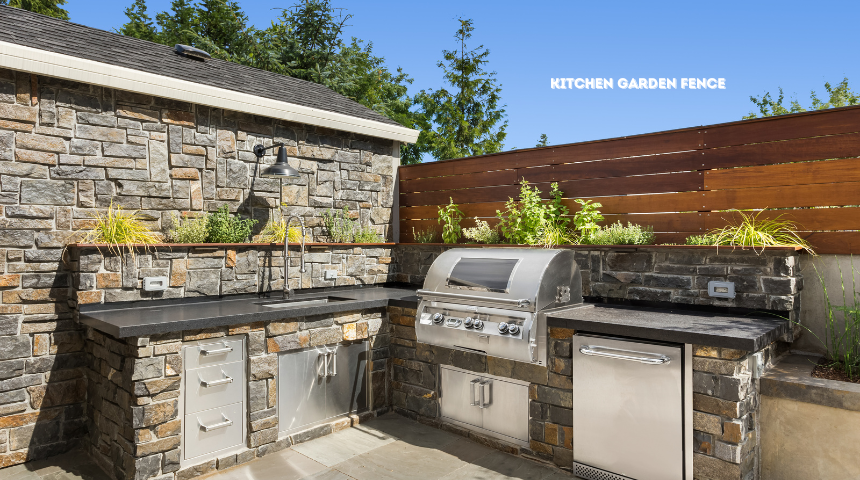As a dedicated gardener, I know the importance of how to fence the vegetable garden effectively. A well-constructed fence keeps pests out and protects my precious plants.
I want to share my experience with you so that you can benefit too.
First, I consider the type of materials. I often choose sturdy wood or metal for durability. Next, I measure the garden’s perimeter to ensure accuracy.
I dig holes for the posts, ensuring they’re deep enough to withstand strong winds. Then, I attach the fencing material securely, checking for any gaps.
Lastly, I always inspect the fence regularly to maintain its condition. This method has kept my garden safe and thriving. With these steps, you can also create a strong and reliable fence for your vegetable garden.
How to fence the vegetable garden?
Fencing a vegetable garden requires some key steps. First, choose sturdy materials like wood or metal. Measure the garden’s perimeter accurately.
Dig post holes deep enough to ensure stability. Place the posts and secure them firmly. Attach the fencing material tightly, leaving no gaps.

Inspect the fence regularly to maintain its strength. This method has kept my garden safe from pests and animals. Following these steps will protect your vegetable garden effectively.
23 Vegetable Garden Fence Ideas to Protect Your Plants
1. Picket Fence
A picket fence adds charm to any garden. It’s classic and functional. Wooden pickets create a barrier while adding a rustic touch. Paint it white for a traditional look or use natural wood for a more organic feel.
This type of fence is not only aesthetically pleasing but also practical. It keeps pets and small animals out, protecting your vegetables from being trampled or eaten.
You can easily install a picket fence yourself, making it a budget-friendly option for many gardeners.
2. Deer Fence
Deer can wreak havoc on your garden. A deer fence can keep them out. Use tall fencing, at least eight feet high. Choose sturdy materials like metal or heavy-duty plastic.
It keeps your plants safe from these hungry visitors. Deer fences are essential if you live in an area with a high deer population.

They not only protect your plants but also prevent the spread of ticks that deer often carry. Investing in a good deer fence can save you from a lot of headaches down the road.
3. Privacy Fence
A privacy fence gives you and your garden some seclusion. Use tall, solid panels to block views. Wood or vinyl are popular choices. It also acts as a windbreak, protecting delicate plants from strong gusts.
Privacy fences can make your garden feel like a secluded oasis, perfect for relaxing. They also reduce noise pollution, providing a quieter environment for both you and your plants.
4. Fenced Compound
Creating a fenced compound can protect larger garden areas. Use sturdy materials like metal or treated wood. It can keep out animals and pests. Plus, it adds an extra layer of security to your garden space.
A fenced compound is ideal for larger gardens or small farms. It allows you to create different zones within your garden, each with its own level of protection.
5. Kitchen Garden Fence
A kitchen garden fence keeps your herbs and veggies safe. Use a low fence with wire mesh. It prevents small animals from nibbling on your produce.

You can also add a gate for easy access. Kitchen garden fences are usually low, making it easy to reach over and harvest your crops. They are perfect for raised beds and small garden plots.
6. Streetside Lattice Fence
A lattice fence is perfect for gardens facing the street. It provides some privacy while letting air flow. Grow climbing plants on it for added beauty.
It’s a stylish way to protect your garden from passersby. Lattice fences are both decorative and functional. They provide a barrier while allowing light and air to pass through, creating a healthy growing environment for your plants.

7. Classic Cottage Garden Fence
A cottage garden fence gives your garden a quaint look. Use picket or split-rail fencing. Add a gate with an archway for a charming entrance. It’s both functional and aesthetically pleasing.
This type of fence evokes a sense of nostalgia and can make your garden look like a scene from a fairy tale. It’s perfect for gardens with a mix of flowers, vegetables, and herbs.
8. Cheap Fencing
On a budget? Use cheap fencing options like bamboo or wire mesh. They’re easy to install and affordable. It keeps animals out without breaking the bank. You can find these materials at most garden centers.
Cheap fencing doesn’t mean compromising on quality. With proper installation and maintenance, these fences can last for several seasons, providing reliable protection for your garden.
9. Fences for Every Purpose
There are fences for every garden need. From protecting plants to adding privacy, you can find a fence that suits your purpose. Consider your garden’s needs and choose the right type of fencing.
Whether you need a fence to keep out deer, protect against wind, or add a decorative touch, there’s a solution available. Tailor your fence choice to your specific gardening challenges.
10. Wood and Wire Panel Fence
A wood and wire panel fence is durable and effective. Use wooden posts with wire mesh. It keeps animals out while providing a sturdy structure. It’s a great option for vegetable gardens.
This type of fence combines the natural look of wood with the strength of wire mesh. It’s particularly effective against small animals like rabbits and groundhogs, which can easily chew through softer materials.
11. Pretty Privacy Fence
A pretty privacy fence can enhance your garden’s look. Choose decorative panels in wood or vinyl. Add some plants along the base for a softer look. It’s both functional and beautiful.
Decorative privacy fences can transform your garden into a tranquil retreat. They provide a visual barrier while adding to the overall aesthetics of your outdoor space.
12. Steel Fence
Steel fences are tough and long-lasting. Use galvanized steel to prevent rust. It’s great for keeping out larger animals. Plus, it adds a modern touch to your garden.

Steel fences are virtually maintenance-free and can withstand harsh weather conditions. They provide a sleek, contemporary look that complements modern garden designs.
13. Rustic Wood Fence
A rustic wood fence adds a natural look to your garden. Use rough-cut wood for a more rustic feel. It’s sturdy and blends well with natural surroundings.
Perfect for a country garden vibe. Rustic wood fences give your garden a cozy, traditional look. They’re ideal for gardens with a natural, unmanicured aesthetic.
14. Ditch The Fence
Sometimes, you don’t need a fence. Use natural barriers like hedges or ditches. They can keep animals out while maintaining a natural look. It’s a low-maintenance option.
Natural barriers can blend seamlessly with your garden, protecting without the need for artificial structures. They also support local wildlife by providing habitat and food sources.
15. Go Electric
For serious protection, go electric. An electric fence can deter even the most determined animals. It’s more expensive but highly effective. Make sure to follow safety guidelines.
Electric fences are excellent for protecting high-value crops or keeping out large predators. They require careful installation and regular maintenance but offer unmatched protection.
16. Beautify A Fence with Flowers
Add beauty to your fence with flowers. Plant climbing roses or vines. They can grow along the fence, adding color and fragrance. It turns a plain fence into a garden feature.
Flowering vines like clematis or honeysuckle can transform your fence into a living wall, enhancing the beauty of your garden while providing an additional layer of protection.
17. Plant Defensive Shrubs
Plant defensive shrubs around your garden. Use thorny plants like holly or barberry. They can deter animals while adding greenery. It’s a natural and attractive barrier.
Defensive shrubs provide a double benefit of beauty and protection. They can be strategically placed to create impenetrable barriers that deter even the most persistent animals.
18. Grow A Living Willow Fence
A living willow fence is both unique and effective. Plant willow rods close together and weave them as they grow. It creates a living, flexible barrier.
Plus, it’s eco-friendly. Living fences grow stronger over time and can be reshaped as needed. They provide a sustainable and attractive alternative to traditional fencing materials.
19. Hang Bird Netting
Bird netting can protect your plants from birds. Hang netting over your garden beds. It keeps birds from pecking at your crops.
It’s lightweight and easy to install. Bird netting is especially useful during the fruiting season when birds are most likely to attack your plants. It can be easily removed and stored when not needed.
20. Set Your Garden In Stone
Use stone walls for a durable barrier. Stack stones to create a low wall. It keeps small animals out and adds a rustic look. Stone walls require little maintenance.
Stone walls blend beautifully with natural landscapes and can double as raised beds or garden edging. They’re ideal for gardens with a rustic or historic theme.
21. Keep Animals Out In Style With Slats
Use slats for a stylish and functional fence. Wooden or metal slats can keep animals out. Arrange them horizontally or vertically for different looks. It’s a modern fencing option.
Slatted fences provide a contemporary aesthetic while offering effective protection. They can be customized with different materials and colors to match your garden design.
22. Modern Vegetable Fence
A modern vegetable garden can benefit from sleek fencing. Use metal or composite materials for a contemporary look. It’s durable and adds a touch of style to your garden.

Modern fencing options often incorporate minimalist design principles, creating clean lines and an uncluttered look. They’re perfect for urban gardens or those with a modern aesthetic.
23. Try A DIY Fence
Try a DIY fence for a personal touch. Use recycled materials like old pallets or doors. It’s cost-effective and creative. You can customize it to fit your garden’s style.
DIY fences allow you to repurpose materials and reduce waste. They can be as simple or elaborate as you like, providing a unique and personalized touch to your garden.
FAQ
Why should I fence my vegetable garden?
Fencing helps protect your crops from pests like rabbits, deer, and other animals.
What materials can I use to build a garden fence?
Common materials include wire mesh, chicken wire, wooden stakes, and PVC pipes.
How tall should the fence be for a vegetable garden?
The fence should be at least 3 to 4 feet tall to deter most garden pests.
How do I install a fence around my vegetable garden?
Dig a trench around the garden, set the fence posts securely, and attach the fencing material.
Are there any natural ways to deter pests without a fence?
Planting companion plants like marigolds or using natural repellents can help keep pests away
Conclusion
Fencing your vegetable garden is essential for protecting your plants. Choose a fence that fits your needs and budget. From classic picket fences to modern steel options, there’s something for every gardener.
Remember to consider the specific threats to your garden, like deer or small animals. Personalize your fence with plants or creative materials for added beauty.
A good fence not only safeguards your veggies but also enhances your garden’s look. Happy gardening and keep those plants safe!
Learn how to fence the vegetable garden with our expert tips. Discover various fencing options to protect your plants effectively.



